About a year ago, I received an email from the School of the Art Institute of Chicago that professor Michelle Grabner would be one of the three curators for the last Whitney Biennial Show to be held at the famed Marcel Breuer building at 945 Madison in New York City. To segue: Marcel Breuer was a Gropius-trained architect from the Bauhaus, the German art school that Hitler closed. His style became part of American post-war architecture brought over by European refugees. The Whitney’s boxy building has an industrial feel as concrete wraps into the inside of the building. How ironic that Deutsche Bank is a major sponsor of the 2014 Biennial.
Last spring I asked Grabner if I could shadow her on her year long adventure of artist selection. I had hoped to peek behind the scenes not only learning some of the politics but just smell the drills as they bit into sheetrock while watching art meticulously measured for hanging. The Whitney press office dismissed my project.
Surprise, two weeks ago I received an invitation to the press conference for the Biennial. Why not take Town Square 49 to the Big Apple? It was spring break and my kennel was full as were most seats on Alaska Airlines. So thanks to husband Dave who held our fort down, I found myself shivering in the cold, waiting to get into the Breuer building along with reporters from around the world.
Once inside I was issued a press pass, the same one they gave the guy in front of me who had flown in from German television with a giant camera. Another segue: having leased the Breuer to the Metropolitan Museum, the Whitney is moving to new digs in lower Manhattan which may explain why they don’t care about upkeep—the Breuer needs to be washed and the floors vacuumed. I managed to get past the usual nonsense of, “don’t go here, don’t touch that.” I bypassed the “you’re kidding, that’s all they’re providing for refreshments” and headed for a rickety chair in the basement; lucky to get a seat. I sat behind a woman bravely saving the empty seat next to her. She said her friend was flying in from Milan. The brief program began with a museum director impersonally thanking his staff and breezily introducing the three curators. There was no question and answer period and the audience was told they had two hours to run through three floors of art and leave before the exclusive cocktail party. My hometown Anchorage Museum wasn’t looking too bad—hey, they give free catalogs and thank yous to the press.
Out on curator Grabner’s fourth floor, New York Magazine’s Jerry Saltz was acquiring a following as he slid around musing how his tabloid can only afford to give him a cheapy point and shoot camera. He stopped to admire a video of two girls wrestling and remarked positively about artist/Art Institute teacher Philip Hanson’s three spiral abstracts, a kaleidoscope of verbiage.
As viewing three floors of art can be overwhelming, I decided to buy a Whitney membership and come back the following day to a members’ preview. Advice: become a museum goer armed with criteria. As a painter I like line, color and form. As a writer I like narrative. I also like to see quirky. Make sure you wear running shoes and arrive fed. Why the Whitney didn’t see the value of having a snack bar for the Biennial is puzzling. I overheard their two thousand dollar plus gala was packed, which may indicate the Whitney is focusing on the elite and not on the family pass crowd, maybe their loss. I bought the Biennial catalog and found a quiet corner. What a disappointment! Much of the art in this book isn’t in the show. Readers can’t tell a video clip from an individual painting.
Michelle Grabner’s picks on floor four abounded with color and texture. This floor is the freshest and best laid out of all three. Artist David Robbins’ video preaches to “take the culture where you want it to go.” His video continues to stress that artists should not listen to curators or anyone else for that matter. Robbins’ statement forces viewers to scratch their heads as to whether artists in this Biennial are in fact altering the culture or happily continuing with the status quo. Is Robbins, who has presently chosen an anti-establishment career, still part of the status quo he protests? As a former Warhol disciple and top banana at his ice cream social, does that give him more leeway to reinvent himself than some unknown trying to make it? Robbins’ modest video is the most sophisticated work in the show and sets the tone for questioning the entire exhibition. Here are my picks.
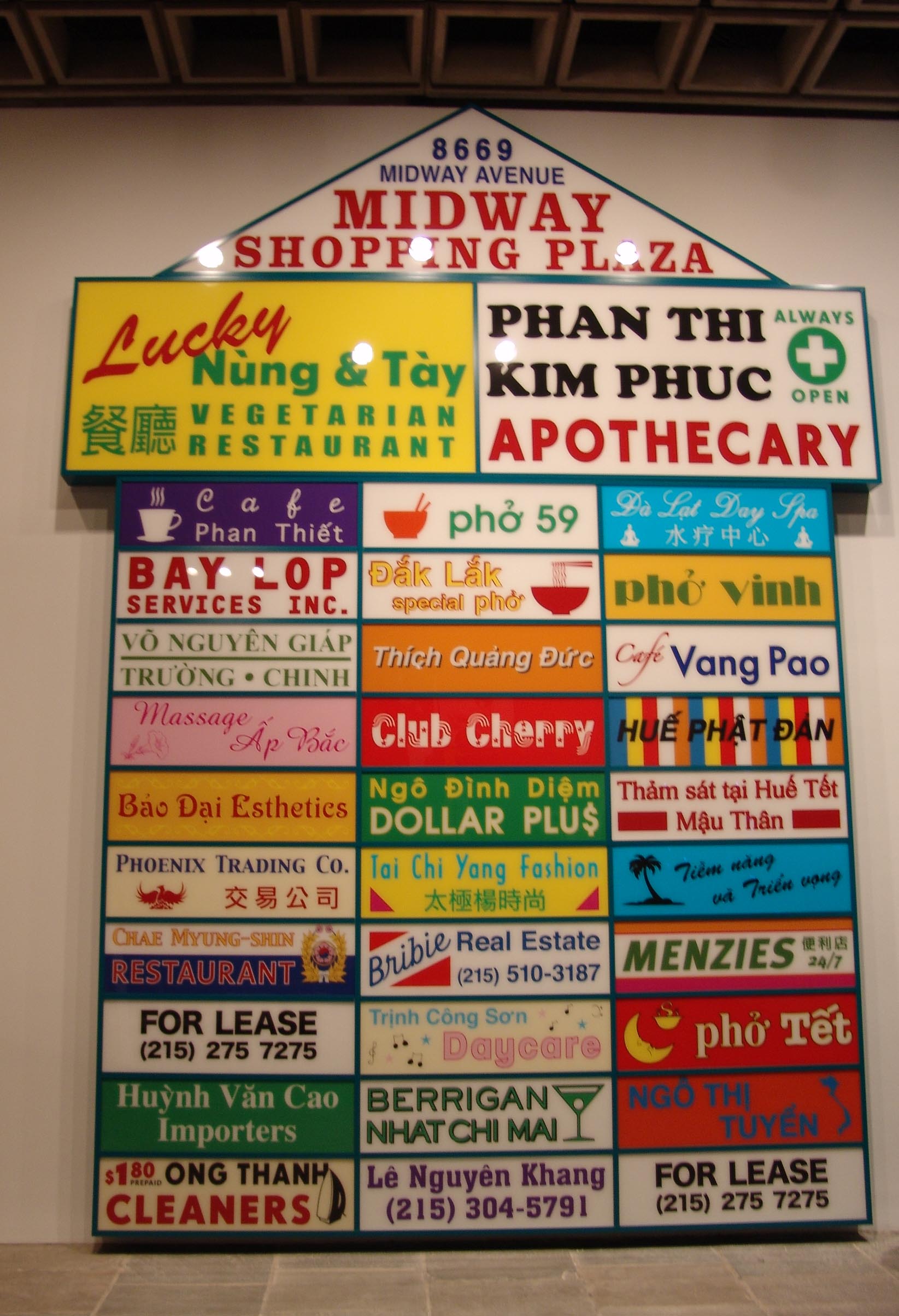
Ken Lum’s Midway Shopping Plaza, 2014, recreation is about American-Vietnamese mall signage contemplated as fine art. Since this is a recreation, would the original receive the same consideration if unscrewed and placed in a gallery? Can viewers see a connection to anti-war New York of the sixties and twenty-first century middle America which has absorbed cultures of those we claim to have conquered?
In Dawoud Bey’s Birmingham Project, 2012, portraits of four African Americans are not posed like CEOs who quietly sit all buttoned up. These folks in casual dress lean out of the picture plane in a manner similar to a Frans Hals painting. They generously pull you into their space, unlike many portraits that repel the viewer. Does it matter that all four are African American?
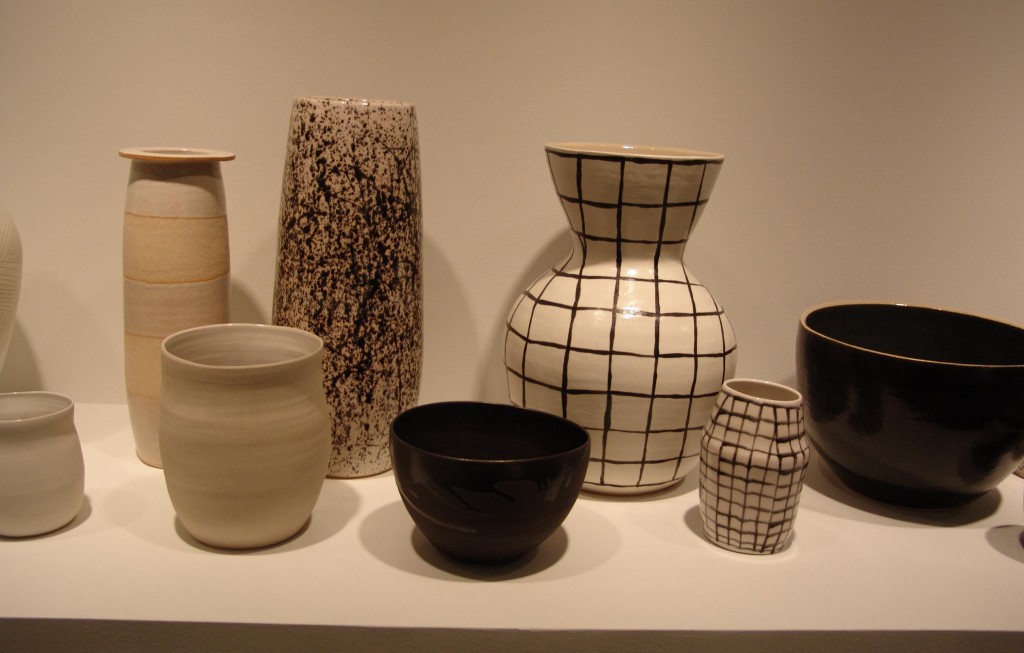
Shio Kusaka’s porcelain and stoneware pots, 2013, are drop dead gorgeous. They are neat, they are texturally interesting. It’s nice that Grabner chose to embrace beauty along with contextual pieces. Why do we find well constructed art forms so hard to embrace?
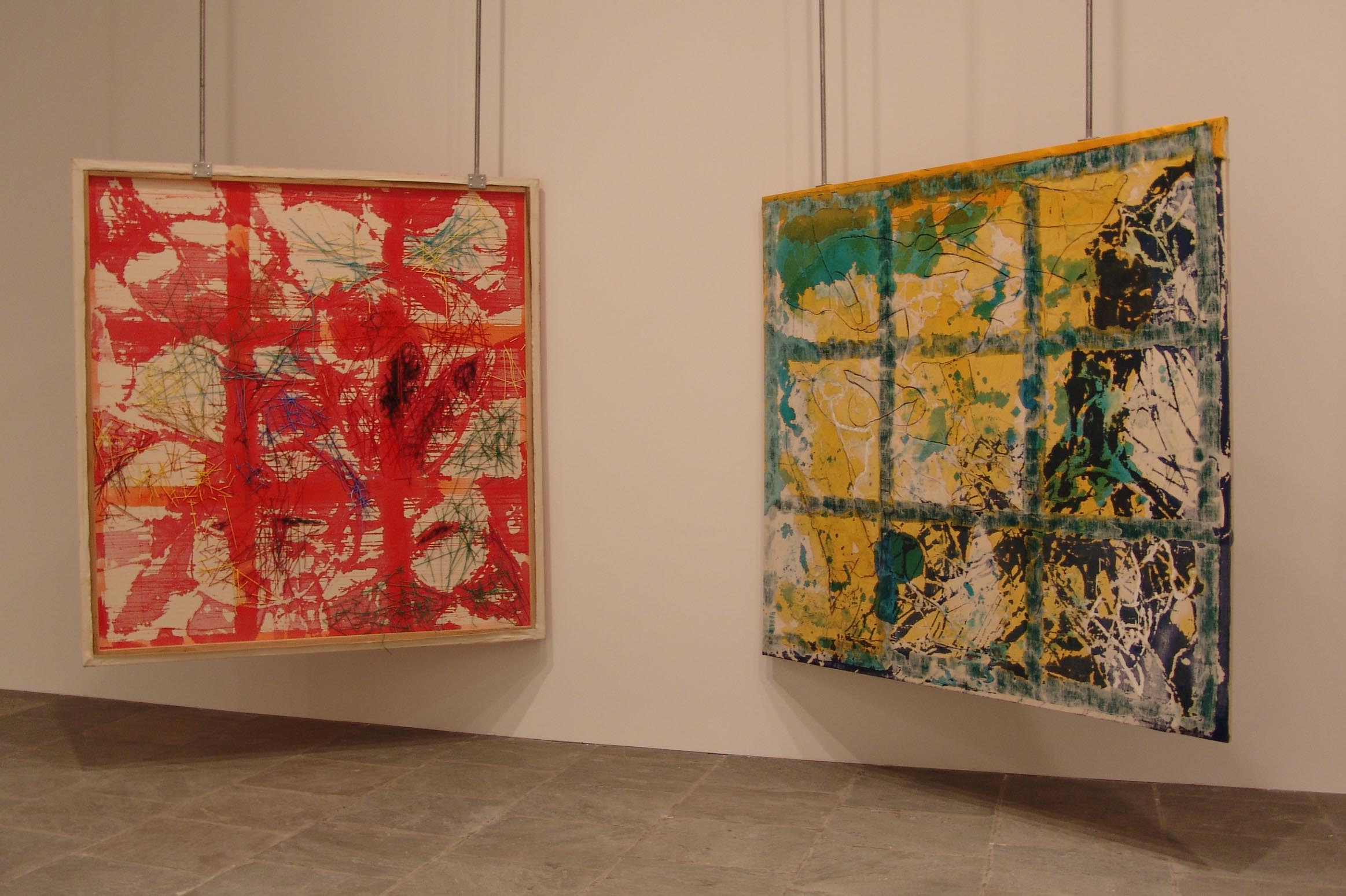
How do you paint something new? Dona Nelson’s Okie Dokie, 2008, are gridded abstracts that hang away from the wall on steel rods. Her lush pigments stain through the canvas so even the backs can be contemplated. Yet her fluidity gets stopped by the implementation of grids and tangled up in yarn sewn into the canvas. Do Nelson’s works pushed away from the wall speak to the craft of needlework most often done by women for low wages and not considered high art?
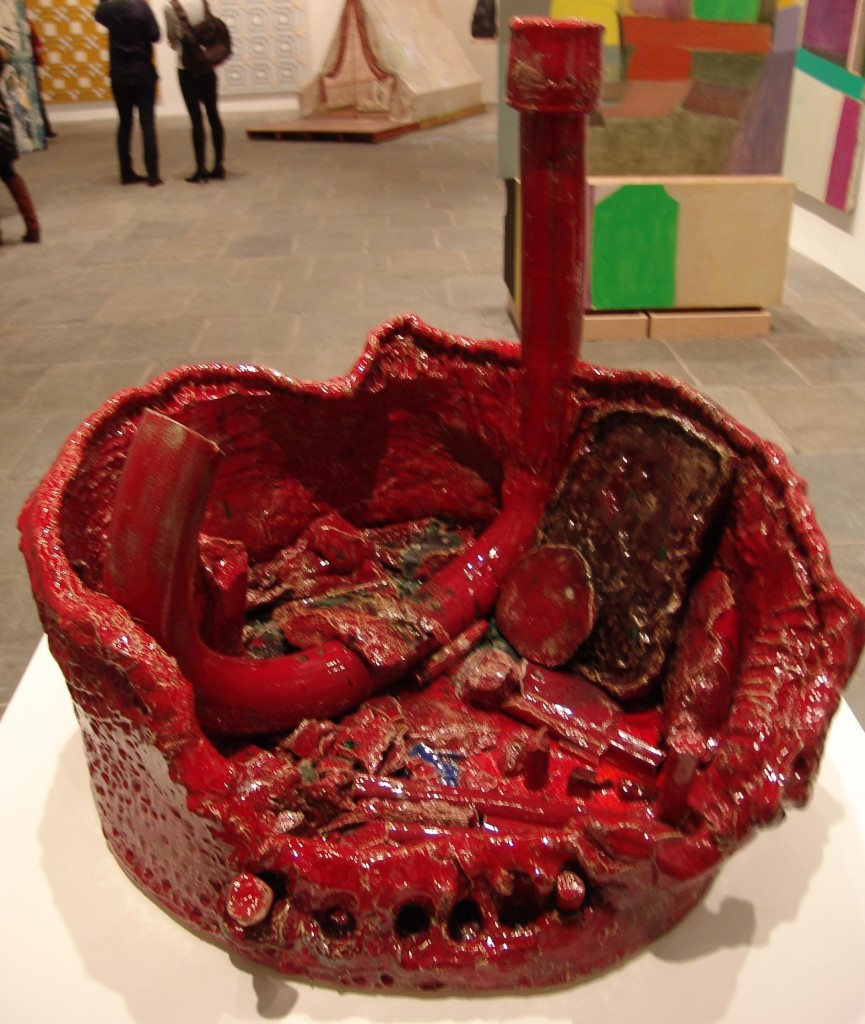
Sterling Ruby’s oversized gawky pottery, Basin Theology, 2013, provides contrast to Kusaka’s finesse. Ruby’s pots looked like something a kindergartener might make only bigger. Inside each piece reside ceramic grotesques of shiny/dull and smooth/pebbly that kept museum goers thinking about blood and guts or industrious sea creatures. Do you have to super-size to make a new point?

I visited the other two floors and found them a bit hackneyed as themes about memory and lost love seemed to dominate; I did find a few treasures.
On Anthony Elms’ floor (curator, Institute of Contemporary Art, Philadelphia) Carol Jackson’s Artist’s Rendering for BLEHH, 2011, is a Baroque-esque frame without a picture. At the top of the frame is a circle where shredded material, maybe the painting, is pouring out. Do we care if the painting was destroyed? How fun to deconstruct this work and contemplate what should replace the destroyed piece—maybe nothing?
On Stuart Comer’s Floor (curator of media and performance at MoMA) Lisa Anne Auerbach harkens back to combining Pop Art and Feminist culture. Auerbach embroiders trivial messages onto stretched surfaces and clothing. She also prints messages onto wearable items. Strike First, 2012, uses wool thread on linen to emphasize trivial phrases like “Say yes to yourself first.” Do we need to elevate narcissistic trivia?
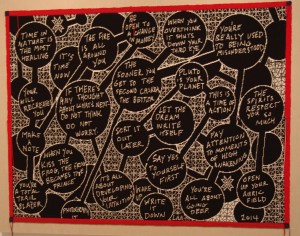
I walked all three floors and here are some of the images that lingered. There was some sort of tent/temporary shelter with a sleeping bag inside beneath kooky chandeliers. I saw beach hats that were sewn together and a bunch of two by fours that looked ready for some sheet rock. George and Barbara Bush’s New York Times wedding announcement hung on a wall while a Cartier clock belonging to FDR was surrounded by, ‘don’t touch’ signage. A harem of nude female dolls practicing auto-erotic maneuvers was very popular as viewers could enter and find one of the few places to sit in this show—walking on the Breuer concrete is nasty. On a monitor, the philosopher Gilles Deleuze was explaining how to be a smart alcoholic while papier mache masks made funny faces harkening back to Greek tragedy. Oh, I almost forgot the stuffed toys hanging like light fixtures in the museum’s dingy stair well.
Anyone can call themselves an artist and produce abstract art or revisit Renaissance Realism and sport a classical narrative. You can even throw laundry on the floor and if you look good at a cocktail party and can speak about those dirty undies while wearing Prada you may be the next artist to be in a pricey Manhattan gallery. You may also have your fifteen minutes of fame and be back flipping burgers.
The Whitney Biennial is still a nice exhibit to investigate what contemporary artists are doing even if they aren’t doing much. I do hope the new Whitney Museum will be more user friendly and have a restaurant as well; oh, and see that catalogs match an exhibition. After all you wouldn’t go to Macy’s to buy pink pajamas and find out later your package contained green cowboy boots that you couldn’t return. Special thanks to Michelle Grabner and my former teacher of High Entertainment, David Robbins. This Biennial breaks away from both coasts and validates that there are good artists in middle America.
Art is everywhere, on the web, on snack food you sheepishly buy when filling your car with gasoline. Art can be viewed and purchased when strolling any resort as you slurp that late night ice cream cone. You can’t avoid art so you might as well jump in and swim in it.
Galleries can be intimidating. So next month I will be taking readers through a day at New York’s Armory Show, an art fair which allows people to view art in a Disneyland fashion. The Whitney 2014 Biennial catalog is available on Amazon.




